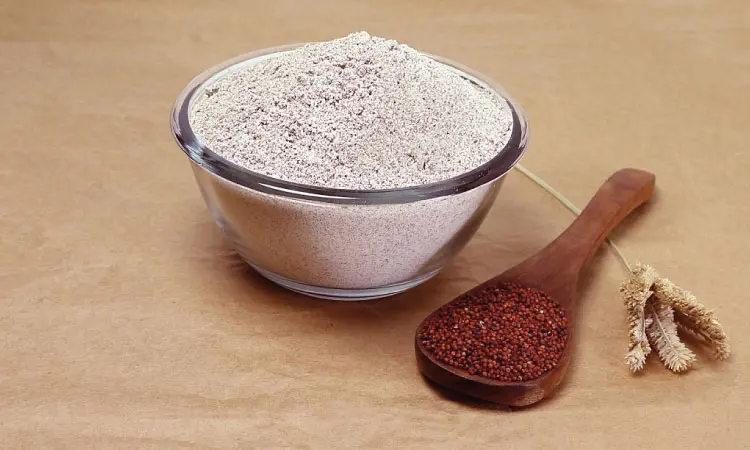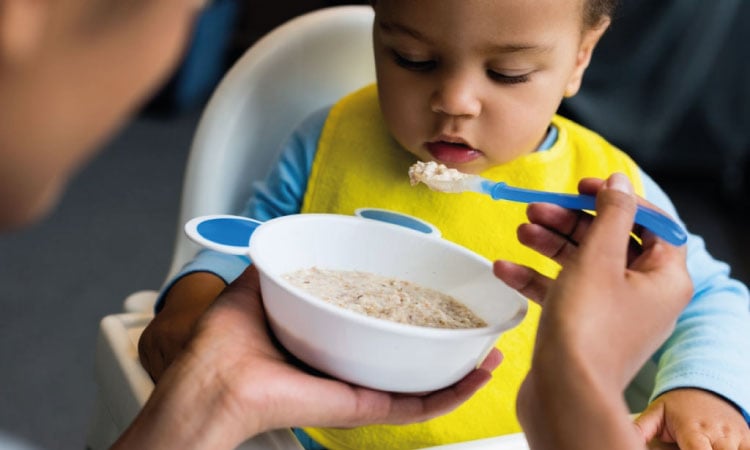Every mom wants their baby to have super nutritious food when it comes to introducing solids. Ragi or Nachni is one such finger millet with so many health benefits introduced by most Indian mothers at an early stage to keep the baby’s growth and development healthy. Hence, Ragi for babies need to be a part of your child’s diet owing to its numerous benefits.
Ragi for babies is one of the best foods that help in gaining weight and strengthening baby muscles. To feed their baby healthily is what all moms think about. Kids on the other hand want something yummy when it comes to snacks or meals. In that case, Ragi comes as the best choice for both moms and kids owing to its versatility!
Let us discuss the best time to give Ragi to babies and why is Ragi good for babies.
What is Ragi?
Ragi is one of the best finger millets to be consumed by both adults and kids. India is one of the leading producers of Ragi, which makes it a common staple in the country. Known by many names such as finger millet in English, Ragi in Kannada, Nachni in Marathi and Gujarati, Mandika in Hindi, Panji Pullu in Malayalam, Ragulu in Telugu, Marwa in Bengali and Nepali, and Kelvaragu or Keppai in Tamil, Ragi for babies helps to strengthen them and provide a good amount of nutrients to babies when consumed on regular basis.
It is easy to incorporate this food in your baby’s diet owing to its variety and is also a powerhouse of nutrients as it adds that extra nutrient boost to a child’s diet plan. As a whole grain, Ragi comes with a good source of protein and mineral content when compared to many other types of cereal. Hence, feeding Ragi for babies either as a porridge regularly or in the form of Dosas, purees or pancakes can help to improve their overall immunity and growth.
Related Reading: 10 Common Reasons Your Baby Is Not Gaining Weight
When And How To Introduce Ragi To Babies?
If you are thinking about when to start Ragi porridge for babies, the best time is to start after the baby completes six months of breastfeeding. Remember to breastfeed the baby until six months or more as it acts as their primary source of immunity.
Also,it is a good idea to introduce millets like Ragi before they become too picky with food. Ragi/Nachni is considered as one good first solid food to start feeding the baby with. You can introduce this food to your baby weeks after you have introduced fruits or vegetable puree.
While most babies show interest in solids between 4-6 months, it is always best to consult your pediatrician before introducing solids to babies. Also, Nachni/Ragi is a super filler that takes some time to get digested. Hence, when introducing this food to your little one, make sure to offer it either in the morning or in the afternoon so that the baby can digest it properly.
Ragi during the initial days can be served in the form of porridge to your little one. Once the child develops hands over eating solids, you can prepare it in the form of Dosa, Idly, pancakes, Parantha, Ragi pudding, Ragi almond cookies, and Ragi Puttu.
Related Reading: 9 Reasons You Feel Your Baby Is Always Hungry (0-1 Years)
To prepare Ragi malt for babies
- Soak Ragi for a few hours in water and grind this soaked Ragi by adding extra water to extract the juice
- Mix the extracted juice with milk and cook
- Add a little sugar (if the child is greater than one year) or jaggery to enhance the taste
- Cook for ten minutes. Keep checking consistency and add more milk for more taste
To prepare Ragi porridge for babies
- Soak Ragi for a few hours and sun-dry it after draining the water completely
- Roast Nachni /Ragi in ghee and grind it into fine powder. Store this powder in an air-tight container
- To make Ragi porridge, take a few spoons of Ragi powder and add sugar (if the child is more than one year) or jaggery for taste
- Mix well and cook until it boils well. Feed to your baby once it is cooled
8 Health Benefits Of Ragi For Babies

Ragi or Nachni is one of the immune-boosting superfoods for babies and growing children when introduced at an early stage, making their growth strong. Not only for children, but it also has numerous health benefits for adults as Ragi is popularly used during pregnancy.
Nachni /Ragi for babies contain fiber-dense bran and other essential nutrients that are not lost due to processing making it a storehouse of nutrients. Ragi/Nachni is rich in dietary fibers, proteins, potassium, and carbohydrates. Also, minerals such as calcium and iron are abundant in Ragi flour.
The below-mentioned benefits of including Ragi for babies will help you take a simple step in making it a part of their daily diet.
1. Ragi for babies is rich in calcium
Growing kids need to have a daily intake of calcium. The amount of calcium in Ragi is high in comparison to other millets. Ragi is also rich in vitamin D. Parents usually rely on milk and other supplements to improve the calcium levels in a baby, which is not the right approach.
An infant needs a good amount of calcium to meet its needs for growing bones and muscles, which can be met by Ragi. An evening snack-based out of Ragi will help fulfill the calcium requirement.
Related Reading: Peanut Butter For Babies- When, How, Risks And Precautions
2. Nachni for babies has high nutritional value
Ragi given in any form to the baby is beneficial due to its nutritional value. It contains a good amount of protein and fiber which is essential for the good health of your baby. It is rich in calcium and easily digestible. This is the reason many moms use Ragi for babies as weaning food. Owing to its starchy content, Ragi helps increase weight in young children, assisting in their routine development.
3. Ragi for babies prevents anemia
Ragi is an excellent source of natural iron and thus helps the child to meet the required iron and hemoglobin levels thereby preventing the child from becoming anemic. Upon sprouting, the vitamin C levels in Ragi increase and lead to easy absorption of iron into the bloodstream.
4. Ragi for babies keeps baby full
Since Ragi is low in fat and is gluten-free, it is easy to digest. Hence, many parents prefer to offer this as the first food to babies in the form of Ragi porridge. Also, since Ragi is rich in proteins and complex carbohydrates, it requires ample time for breakdown and assimilation in the system.
Hence it is best recommended to feed your child Ragi malt or Ragi flour-based Rotis, Puttu, or Dosas in the morning for breakfast, or during the afternoon for lunch. It is best avoided as the last meal of the day, because it will take time to digest.
5. Nachni for babies boosts immunity
Ragi is a superfood that comes with a powerhouse of vitamins and minerals. The various nutrients present in Ragi help the baby improve and build a good immune system. Since babies have a weak immune system and are easily prone to catching infections quickly, including foods such as Ragi will help keep infections and diseases at bay.
6. Ragi for babies help in weight gain
The high nutrition level in Ragi helps the babies in gaining good weight. Ragi has a dense nutritional value in dietary fibers, calcium, iron, proteins, and Vitamin B1 and B2. Hence, Ragi proves to be the superfood for babies that makes them gain weight easily.
7. Ragi helps babies relax

Ragi is a rich source of several amino acids. Tryptophan — an amino acid present in Ragi has the property of increasing the body’s level of serotonin, a precursor to the hormone melatonin, that helps the kids sleep to better.
8. Nachni helps in relieving constipation
Babies who consume milk or formula are easily prone to constipation issues. The fiber content in Ragi helps to regulate the baby’s bowel movement and relieves constipation problems in babies.
Related Reading: How And When To Use Apple Juice For Baby Constipation (Till 2 Years)
Risks Of Giving Ragi To Babies
Feeding your little one could be a difficult task as kids tend only to pick up food that appeals to their taste buds. To meet their taste buds and nutritional value, it could be tough for parents to choose the best. Though many benefits of Ragi for babies have been discussed, many parents are also curious to know about the disadvantages of Ragi for babies.
Eating any food in excess could have some side effects and there are certain common foods that should not be given to babies. Of the many foods that we give to our babies, one criterion is a few traditional foods that our moms tell us they fed us and insist on feeding our babies with it too. A good option for babies but one must be very careful about the disadvantages of Ragi for babies too.
1. Takes time for digestion
Ragi flour is cooked into porridge or steam cooked into Ragi balls before feeding the infant. Since this is a superfood with a high dense nutritional value, the digestion time may take longer than usual.
2. Unprocessed Ragi might harm
The type of Ragi flour for the baby must be picked with caution. The Ragi flour meal. given to. babies must be made out of sprouted Ragi. Since many store-bought ones may not be of this kind, it is always better to go for processed ones as otherwise, it may tend to load up the kidneys.
3. Ragi can cause cold
Many moms feel Ragi for babies can cause colds if given during wintertime. Though Ragi is one of the cold foods, it is ok to offer it anytime during the day. Nonetheless, pediatricians suggest giving Ragi to babies in small amounts doesn’t cause much harm, it is always better to go by the mom’s instinct to offer depending on how the baby reacts upon feeding it.
Related Reading: Are Bananas, Milk Or Curd Given To Babies When They Have Cold?
4. Risk of obesity

Ragi is a superfood that is known for promoting the baby’s weight. If your baby is already at risk of juvenile obesity, it is a good reason to avoid offering Ragi to your baby.
FAQs
Yes, Ragi for babies can be included daily as part of their diet. Make sure to offer it in small quantities only once per day as this dense food takes much time to get digested. Ragi can be given to babies from 6 months.
You can start offering Nachni for babies with 1 tablespoon of Ragi porridge and check whether the baby shows an allergic reaction. Follow the three days rule to ensure the baby is not allergic to it. You can gradually increase the amount. Once the baby is used to it, you can introduce varieties to it.
Ragi is a superfood that helps to increase the baby’s weight easily and naturally. It is rich in dietary fiber, calcium, iron, proteins along with vitamins B1, B2, and many other minerals.
When you use millets like Ragi in place of rice or wheat in your child’s diet – your child’s diet becomes healthier as it provides more nutrients for cell development and body growth leading to weight gain. You can also add ghee or mashed bananas to the Ragi porridge for more taste and quick weight gain.
Ragi is believed to reduce body heat and hence it is safe and is good to offer Ragi for babies during summer. However, make sure to give it in moderation and follow the three-day wait rule.
Also, keep in mind that Ragi is one of the cold foods which could cause colds to babies depending on their bodies. Hence it is always best to contact your pediatrician to know if it can be offered during winter.

